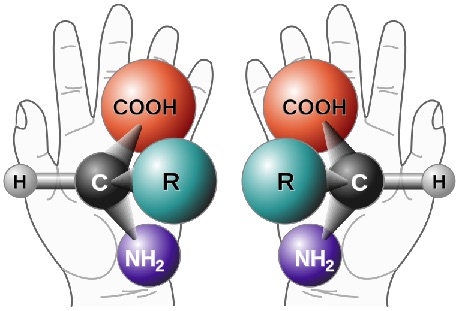B.10 Stereochemistry in biomolecules
Written specifically for students to provide help and support for the IB Diploma chemistry programme this page provides full coverage of the syllabus content of Option B - sub topic B.10. It encourages you to think critically and provides many questions with full worked answers so that you can monitor and improve your knowledge and understanding.

 Learning outcomes
Learning outcomes
 After studying this topic you should be able to:
After studying this topic you should be able to:
Understand:
- All 2-amino acids (other than glycine) are chiral, and only the L-configuration is found in proteins.
- Unsaturated fats that occur naturally are mostly in the cis- form, although food processing can convert them into the trans- form.
- D and L stereoisomerism of sugars refers to the configuration of the chiral carbon atom furthest from the aldehyde or ketone group. The D forms occur most commonly in nature.
- Cyclic forms of sugars have α and β isomers. If the position of the hydroxyl group at carbon 1 (glucose) or carbon 2 (fructose) lies below the plane of the ring it is the α form and if it lies above the plane of the ring it is the β form.
- The chemistry of sight involves the light activated interconversion of cis- and trans- isomers of retinal.
- Describe the hydrogenation and partial hydrogenation of unsaturated fats. Include the production of trans-fats, and discuss the advantages and disadvantages of these processes.
- Explain the structure and properties of cellulose, and compare with starch.
- Discuss the importance of cellulose as a structural material and in the diet.
- Outline the role of vitamin A in vision, including the roles of opsin, rhodopsin and cis- and trans-retinal.
Relationships & vocabulary
Nature of science
The biological activity of chiral molecules is often specific to just one enantiomer. Chemical reactions involving a chiral environment provide a guiding distinction between living and non-living matter.
International-mindedness
The standards of food labelling with respect to its chemical content, including the type of fats present, can vary greatly from country to country.
Vocabulary
| starch | amylose | amylopectin | cellulose |
| rhodopsin | opsin | cis-retinal and trans-retinal |
Learning slides
You can use this slide gallery for learning or for reviewing concepts and information. It covers all the key points in the syllabus for this sub-topic.
Something to think about
The syllabus states clearly that you need to understand that with one exception, amino acids are chiral, and only the L-configuration is found in proteins.
Chirality is no problem but if you are to understand that only the L-configuration is found in nature then you need to be able to distinguish between the L- and D- forms of 2-amino acids. The syllabus does specifically require you to be able to distinguish between the L- and D- forms of sugars such as glucose and fructose and gives clear details on how to do this. Similarly it explains how to distinguish between the α and β forms of cyclic sugars. However no mention is made under ‘Applications and skills’ of using the CORN rule for 2-amino acids.
The rule is actually quite simple. The molecule needs to be positioned so that the hydrogen atom is pointing away from the viewer. This brings the other three groups to the front. If the order going clockwise is –COOH, -R, -NH2 then it is the D- enantiomer and if the CORN order is going anticlockwise then it is the L- isomer.

Left hand CORN is anticlockwise so L-configuration, right hand CORN is clockwise so D-configuration.
(Image from Wikimedia commons)
It really is not at all clear whether you need to know this but how else can you be expected to distinguish between the L- and D- forms of 2-amino acids?
Test your understanding of this topic
(Note that your teacher may have restricted your access to some or all of these questions and worked answers if they are going to use them as a class test or set them as an assignment.)
For ten 'quiz' questions (for quick testing of knowledge and understanding with the answers explained) see MC test: Stereochemistry in biomolecules.
For short-answer questions see Stereochemistry in biomolecules questions together with the worked answers on a separate page Stereochemistry in biomolecules answers.
More resources
1. A very simple, but to the point, video by Bite Sci-zed on saturated and cis- and trans- unsaturated fats describing what they are and the factors affecting their melting points.
2. Fischer projections. How to distinguish between the D- and L- forms of sugars.

 IB Docs (2) Team
IB Docs (2) Team